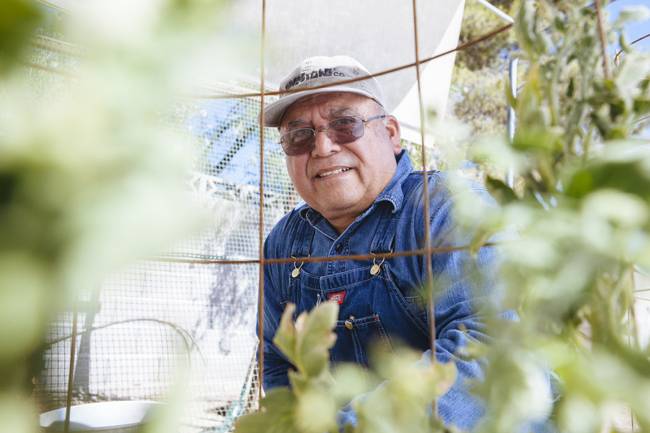Leonard Rosales knew something was wrong last year when he began noticing unusual symptoms. Constantly thirsty, he experienced sporadic episodes during which he simply felt “off,” his body indicating that something was definitely wrong.
“I just felt strange,” the Las Vegas resident said.
His primary care physician with HealthCare Partners Nevada confirmed his suspicions: He appeared to be prediabetic, his high blood sugar the cause of his sudden health issues. This was not wholly unexpected; Rosales had watched several close family members develop type 2 diabetes, one of them experiencing severe complications. Rosales, 66, is also overweight, a top risk factor for the disease.

“Developing diabetes really worries me,” he said. “I’ve seen what happens to people with this disease.”
It wasn’t all bad news, however. His doctor offered an encouraging outlook, with a slight catch. Rosales could manage his blood sugar, and possibly even avoid developing diabetes entirely, by making significant lifestyle changes.
It primarily came down to changing what he put on his plate.
“Now I’m checking the ingredients and the portions of what I’m eating. It’s something I never thought about before,” Rosales said.
Although it hasn’t been easy, he has help. Rosales has received educational materials and direct support from HealthCare Partners Nevada, a leading medical organization offering 310 primary care providers and more than 1,700 specialists across Southern Nevada.
With his new focus on nutrition, he is on his way to improving his condition.
“I’m feeling better,” Rosales said. “I’m hoping to turn this around.”
He is far from alone in this battle. Diabetes is increasingly common across the U.S., including Southern Nevada. One in 10 adults in the U.S. currently has diabetes, according to the Centers for Disease Control and Prevention, a number that is projected to double or even triple by 2050.
Dr. Sunita Kalra, primary care physician with HealthCare Partners Nevada, estimates that roughly 35 percent of her patients have diabetes, and the majority have type 2 diabetes.
“I think many people are unaware that diabetes can occur at any age,” Kalra said.
A metabolic disease in which the body doesn’t produce enough or sometimes any insulin, diabetes causes elevated glucose levels in the blood. Type 1 diabetes, often diagnosed during childhood, is caused by genetics and other unknown factors, while type 2 diabetes can develop at any age, the result of genetics and lifestyle issues such as being overweight.
Mismanagement of diabetes can initially have minimal or no symptoms. But left unmanaged or poorly managed, diabetes can lead to severe health issues over the long term, including heart attack, kidney issues and lower leg problems that can result in amputations of the toes and legs.
Having diabetes doesn’t have to be a death sentence, however, nor does it even have to be an inconvenience, if properly addressed. For individuals with type 2 diabetes, it is even possible to reverse the condition completely by taking the proper steps.
“Diabetes is no longer the frightening diagnosis it once was,” Kalra said. “We can really manage it.”
Diet is key
The key to managing diabetes is simple: proper nutrition.
“Nutrition is very important for diabetics because it is key for controlling their overall blood sugar,” Kalra said.
The chief step for diabetics to prevent complications from the disease is to avoid an excessive intake of food high in sugar, which raises the blood’s glucose level. Because diabetic bodies are developing minimal amounts to none of the hormone insulin, which plays a key role in circulating sugar from the blood into cells, glucose will build up in the blood, leading to health issues. Even without ingesting sugary foods, the human body produces glucose naturally, so diabetics already have to worry about their natural glucose levels without adding more from sugary foods, Kalra said.
“Diabetics don’t have to avoid sugar entirely,” Kalra said. “The best advice is to simply eat everything in moderation. It’s not that diabetics can’t eat a single cookie, they just can’t indulge a craving and eat the whole bag. Portion control is everything.”
The American Diabetes Association recommends for diabetics to consume roughly 45 to 60 grams of sugar per meal. (One sugar cube is 4 grams of sugar; there are 39 grams of sugar in one can of regular Coke.) Keeping sugar consumption in check involves more than just avoiding candy and desserts, Kalra said. It also requires avoiding a high intake of carbohydrates such as bread, pasta and starchy vegetables such as potatoes, which the body converts into glucose during digestion.
There are a variety of foods diabetics can substitute for these items, Kalra said.
She recommends a low-carbohydrate diet of non-starchy vegetables such as lettuce and broccoli, whole grains and lean protein such as chicken and fish, with allowances for fruits with lower sugar levels.
To help with portion control during meals, the ADA suggests restricting one-fourth of a plate for starchy foods, filling half the plate with non-starchy vegetables, and saving the final quarter of the plate for foods high in protein.
Kalra has observed that some patients have more success than others with adjusting to the diabetic diet. Many struggle during the holidays, when there is often an abundance of foods high in sugar and carbohydrates.
“The biggest thing to keep in mind is that this is not like going on a diet,” Kalra said, adding that these dietary recommendations apply to individuals with type 1 and type 2 diabetes. “It’s a lifestyle change that diabetics must incorporate into their daily lives.”
A new lifestyle
Hearing that he had to dramatically change his diet was tough news for Rosales.
He was raised in an environment immersed in food, his parents operating a restaurant and catering business. He went on to work in the restaurant industry himself, developing a strong appreciation for his product.
“I like to eat,” Rosales said with a chuckle, admitting that his meals were often heavy in carbohydrates such as potatoes, French fries and rice, all of which contribute to higher blood sugar. “It bothers me a little to restrict what I eat.”
Learning about the healthiest foods for diabetics has helped him adjust. HealthCare Partners Nevada provided him with booklets about diabetes and nutrition and his doctor advised him on obtaining a blood sampling device to measure his blood sugar every day. HealthCare Partners Nevada also offers classes about managing diabetes. In addition, nurses are available to counsel diabetic patients one-on-one about their condition.
“We have a great support network for patients,” Kalra said.
This support has helped Rosales become more mindful of what he consumes. He has learned to read nutrition labels and keeps a daily log of his meals, in addition to checking his blood sugar after every meal.
“I write down what I’ve eaten and then I check my blood sugar,” he said. “If it goes up, I give up what I was eating.”
He is eating vegetables from his garden a little more, and visiting his favorite buffets a little less. His commitment has paid off, with his blood sugar dropping up to 50 percent from its highest point.
For overweight diabetics, Kalra suggests pairing nutritious eating with weight loss. Overweight individuals can significantly improve their blood sugar by losing just 5 to 10 percent of their overall body weight, according to the CDC.
Following these nutrition recommendations and maintaining a healthy weight can make diabetes a controllable disease, Kalra said. Individuals with type 2 diabetes who follow a nutritious diet and reach a healthy weight typically don’t experience any health complications and often don’t need medications, she adds. She has even observed patients completely reverse their condition by making dramatic lifestyle changes.
“This is only possible for patients with type 2 diabetes,” Kalra said. “Those with type 1 diabetes have a complete deficiency of insulin, meaning their condition can never be reversible. However, they can limit the amount of medications they need by following a nutritious diet and exercising.”
Worst-case scenarios
Not everyone handles diabetes well, Kalra said.
Those who fail to kick their sugar habits and remain at an unhealthy weight can experience extreme health issues. These can include damage to blood vessels in the kidneys, resulting in kidney failure, as well as retinopathy, which occurs when small blood vessels in the eye become damaged, leading to vision loss. High glucose levels among diabetics can also lead to neuropathy, or nerve damage, which can cause toe and foot deformations, as well as loss of feeling in the foot, hindering people’s ability to recognize when their feet are injured, according to the ADA.
Poor circulation is also a common symptom. It can cause blood vessels in the feet and legs to harden.
Because of the many foot and leg issues diabetics can experience, they are far more likely to have a foot or leg amputated that those without the disease, the ADA says.
Heart attacks are one of the most common of diabetes’ extreme complications, Kalra said, as a result of high blood sugar damaging nerves and blood vessels.
“These complications occur among diabetics who have extremely advanced cases,” she said, noting that just 4 to 5 percent of diabetics in her patient population have experienced such issues. “If diabetes isn’t properly managed or isn’t caught in time, the disease can have a severe impact on the body.”
Rosales is well acquainted with the potential complications of diabetes. Of his many relatives with diabetes, one immediate family member experienced the worst symptoms, he said.
These included vision issues that nearly led to blindness, he says. She also experienced complications with her lower extremities. Her doctors first amputated her toes, he recalls, then worked their way up to the feet and legs.
“That was definitely concerning,” he said. “This is why people need to watch their diets, to try not to get to that point.”
Making the right choices
Rosales has noticed significant improvements in his health since his doctor first spoke with him about addressing his diet and lifestyle last year. He has more energy to engage in activities beneficial to his health, and he isn’t experiencing the episodes he previously noticed.
“I’m always outside being active, working in my garden or in the yard,” he says.
Such positive results are possible for many people with prediabetes and diabetes, Kalra says, if they take the steps to manage their condition and meet regularly with their primary care providers to monitor for complications.
“People can enjoy a healthy, active life with diabetes,” Kalra says. “For those who learn how to manage the disease and make the right choices, this disease never has to lead to significant health problems.”
